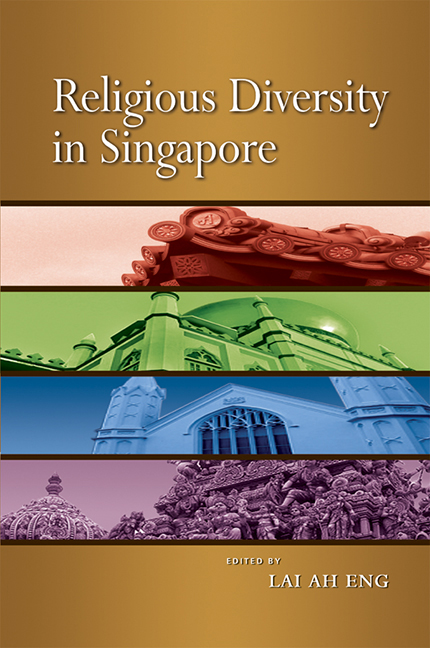Book contents
- Frontmatter
- Contents
- List of Figures and Tables
- List of Appendices
- FOREWORD
- PREFACE
- Acknowledgements
- The Contributors
- Abbreviations
- Glossary
- INTRODUCTION
- PART I The Landscape of Religious Diversity
- 1 Religious Influences and Impulses Impacting Singapore
- 2 Religious Trends and Issues in Singapore
- 3 Keeping God in Place: The Management of Religion in Singapore
- 4 Discourses on Islam in Southeast Asia and Their Impact on the Singapore Muslim Public
- 5 Global Christian Culture and the Antioch of Asia
- 6 “Religiously-inspired”, “India-derived” Movements in Singapore
- 7 Baha'is in Singapore: Patterns of Conversion
- 8 Diversities and Unities: Towards a Reformist Buddhism in Singapore
- 9 The Sathya Sai Baba Movement in Singapore: Its Service Mission and Philosophy of Communal Identity Construction
- 10 The Muslim Religious Elite of Singapore
- 11 The Evolution of the Sikh Identity in Singapore
- 12 Religious Processions: Urban Politics and Poetics
- PART II Religion in Schools and Among the Young
- PART III Religion in the Media
- PART IV Religious Organizations in Social Services
- PART V Interfaith Issues and Interaction
- Index
3 - Keeping God in Place: The Management of Religion in Singapore
from PART I - The Landscape of Religious Diversity
Published online by Cambridge University Press: 21 October 2015
- Frontmatter
- Contents
- List of Figures and Tables
- List of Appendices
- FOREWORD
- PREFACE
- Acknowledgements
- The Contributors
- Abbreviations
- Glossary
- INTRODUCTION
- PART I The Landscape of Religious Diversity
- 1 Religious Influences and Impulses Impacting Singapore
- 2 Religious Trends and Issues in Singapore
- 3 Keeping God in Place: The Management of Religion in Singapore
- 4 Discourses on Islam in Southeast Asia and Their Impact on the Singapore Muslim Public
- 5 Global Christian Culture and the Antioch of Asia
- 6 “Religiously-inspired”, “India-derived” Movements in Singapore
- 7 Baha'is in Singapore: Patterns of Conversion
- 8 Diversities and Unities: Towards a Reformist Buddhism in Singapore
- 9 The Sathya Sai Baba Movement in Singapore: Its Service Mission and Philosophy of Communal Identity Construction
- 10 The Muslim Religious Elite of Singapore
- 11 The Evolution of the Sikh Identity in Singapore
- 12 Religious Processions: Urban Politics and Poetics
- PART II Religion in Schools and Among the Young
- PART III Religion in the Media
- PART IV Religious Organizations in Social Services
- PART V Interfaith Issues and Interaction
- Index
Summary
INTRODUCTION
We have enjoyed racial and religious harmony since Independence. This does not prove that our social fabric is inherently stronger than other multi-racial societies, or that we are immune to the serious problems which have afflicted so many of them. It only shows the amount of care which has gone into tending it and strengthening it.
(Shared Values White Paper 1991, p. 4)Singapore has enjoyed racial and religious harmony since its independence in 1965. What is not so evident is the tremendous care, effort, and pre-emptive prudence invested in nurturing multi-religiosity as an integral part of Singapore's multi-racialism framework. Buttressed by the state's professed commitment to secularism, racial and religious harmony is one of Singapore's five Shared Values. This stability is jealously guarded by the state especially since rapid modernization has neither resulted in the decline of religious belief nor the downgrading of importance of religious institutions among Singaporeans. Religious faith is a “major part of Singapore's cultural ballast” and exerts a tremendous pull on Singaporeans (Shared Values 1991, p. 8; Tong 2002). Singapore's rich religious heritage is also celebrated as a source of strength, with places of worship attended in large numbers by locals and promoted as tourist sites of interest. Singapore's architectural landscape, with many prominent religious buildings, is a legacy of religious developments in early modern Singapore history (Lee Geok Boi 2002). Yet, consider the paradox: religion has been selectively co-opted in secular Singapore's nationbuilding process. Can a strong religious identity co-exist with a strong Singaporean identity?
This chapter begins with a description of the multi-religious landscape of Singapore and notes some aspects of the religious state of play. It then examines the institutional and legal framework in the management of religion within the context of an evolving, putative Singapore model of secularism. The policy impulses behind the state's co-option of religion to reinforce the teaching of moral values, to sustain economic vitality, and to urge the practice of one's religion in keeping with the secular and multi-racial mores of Singaporean society are examined. It shows that the state engages in a tightrope walk between secularism and control and influence over religion, and religious expression for the purposes of state- and nation-building.
- Type
- Chapter
- Information
- Religious Diversity in Singapore , pp. 55 - 82Publisher: ISEAS–Yusof Ishak InstitutePrint publication year: 2008

